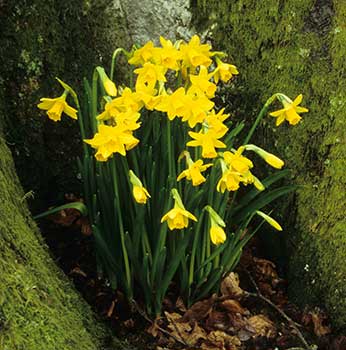Wild daffodil (Narcissus pseudonarcissus)
When: Blooms from February to April
How many: Relatively scarce

Daffodils are too well known to warrant the inclusion of a description here, but it is less commonly appreciated that in the wider countryside, away from the New Forest, a totally wild variety can sometimes be found growing in damp woodlands, copses and spinneys; on old hedge-banks and in shady, unimproved meadows.
In Hampshire, the wild daffodil is said to be locally common, particularly on wooded valley slopes and beside their streams, and in some places occurs in good numbers. In the New Forest, however, only scattered populations are likely to be encountered and abundance is something of a rarity.
A short to medium sized perennial that typically attains a height of up to 36 centimetres (14 inches), the wild daffodil was the forerunner of the many cultivated varieties so popular in gardens and ornamental displays. Indeed, close to places of habitation and other plantings, originally cultivated varieties- escapes - can sometimes be found growing well in the wild.
In bloom from February to April, the wild daffodil in many country areas was once considerably more common than it is now, but numbers markedly declined, particularly around the mid-19th century, as a result of woodland clearance, woodland neglect that allowed increased light to let brambles become established, general land improvement, drainage initiatives and pilfering for trans-plantation into gardens. But as the leaves are poisonous to livestock, grazing by New Forest deer and commoners' animals would seem not to have been a threat to daffodil population numbers. (John Wise, writing in 1863, simply referred to occurrence of the plant on the south side of the Forest, near Wootton).
William Wordsworth, of course, immortalised the daffodil in his poem commonly known by the same name, which memorably begins with the words: I wandered lonely as a cloud, That floats on high o'er vales and hills; When all at once I saw a crowd, A host, of golden daffodils; Beside the lake, beneath the trees, Fluttering and dancing in the breeze.
Although usually especially concentrated in the bulb, virtually all parts of the plant contain toxic alkaloids that if eaten can cause dizziness, abdominal pain, diarrhoea and occasionally convulsions. In small doses, however, the bulb has been used as a purgative and emetic, and in the 17th century was recommended by Nicholas Culpeper for use against all obstructions in the body.
References:
The Flora of Hampshire: Anne Brewis, Paul Bowman and Francis Rose
The Wild Flowers of Britain and Northern Europe: Richard Fitter, Alastair Fitter and Marjorie Blamey
The New Forest - its history and scenery: John Wise
The Englishman’s Flora: Geoffrey Grigson
Field Guide to the Wild Flowers of Britain: various contributors
Culpeper's Complete Herbal: Nicholas Culpeper
More links
Other related links
Search this site

Sadly, 58 animals were killed - 35 ponies, 13 cows, 8 donkeys and 2 sheep, whilst a further 32 were injured - 3 pigs, 9 donkeys, 11 cows and 9 ponies.
(Forty-three accidents occurred in daylight, 15 at twilight and 101 in the dark. Twenty-seven accidents were not reported by the driver involved).
Here's just one horrific example - Three donkeys killed in collision with van at notorious New Forest blackspot (Advertiser and Times)

